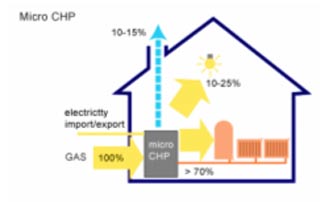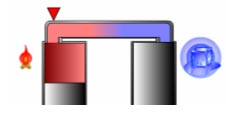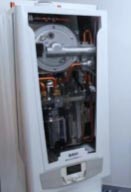In the race to reduce traditional fossil fuel usage for domestic heating and power generation, many new technologies have emerged and one such is Micro CHP.
In tis project guide we take a look at this exciting new technology and how it can be used on a domestic level to generate both heat and electricity.
Micro CHP: The Basics
Micro CHP (Combined Heat and Power) systems are compact units designed for home use. They replace your boiler and use mains gas or LPG (Liquid Petroleum Gas) to provide both heating and hot water for your central heating system.
Unlike industrial CHP systems that generate heat as a by-product of electricity, micro CHP systems generate heat first and produce electricity from that heat. Typically, they produce about 6 units of heat for every 1 unit of electricity.
Micro CHP is a low-carbon technology because it creates electricity from waste heat instead of burning extra fossil fuels. As a result, domestic CHP installations can earn money through the FIT (Feed-In Tariffs) Scheme (no closed), paying 11p/kWh for the electricity generated at peak, but this decreased greatly up until the scheme shut down.
Here are the typical financial benefits of a micro CHP system:
- Save around £60 on your electricity bill
- Earn approximately £180 a year from the Generation Tariff for each unit of electricity you generate
- Receive around £30 a year from the Export Tariff (4.5p/kWh) for excess electricity sent to the grid
- Total potential annual benefit: £ 270
- Finance installation through the Green Deal scheme, which lets you pay back through your energy savings (now ended and not taking new applications)
The Stirling engine is the primary micro CHP technology for homes, producing around 1 kW of electricity per hour, meeting about 46% of an average home’s electricity needs. Other CHP technologies, like internal combustion engines and fuel cells, are used commercially but are not yet developed for home use, more on this later.

Micro CHP system efficiency diagram
How Micro CHP Systems Work
Micro CHP (Combined Heat and Power) systems generate electricity and heat for your home using a condensing boiler and a Stirling engine.
Here’s a simple breakdown of how they work:
- Heat Production: The condensing boiler heats water for your central heating and hot water needs.
- Power Generation: The steam from the boiler drives a Stirling engine to produce electricity.
- Stirling Engine Mechanics: A Stirling engine consists of gas-filled tubes with pistons. One tube is heated while the other is cooled, causing the gas to expand and contract. This movement drives the pistons up and down.
- Electricity Generation: The pistons’ movement turns an electrical generator, producing electricity efficiently and quietly.
Micro CHP systems are effective for generating both heat and power, making them a great choice for efficient home energy solutions.

Micro CHP condensing boiler heating hot water diagram
What Are the Different Micro CHP Technologies?
Micro CHP (Combined Heat and Power) technologies are innovative solutions that provide both heat and electricity for homes and small businesses. These technologies come in several types, each using different methods to convert energy into both heat and power. Understanding these technologies can help you choose the right system for your needs. The main Micro CHP technologies today are as follows:
Stirling Engine Micro CHP
The Stirling engine is one of the most common micro CHP technologies. It works by using a sealed chamber filled with gas, which is alternately heated and cooled. The heat from the condensing boiler drives the gas, causing it to expand and contract, which moves pistons and generates mechanical power. This mechanical power is then converted into electricity. Stirling engines are known for their high efficiency and quiet operation, making them a popular choice for residential micro CHP systems.
Internal Combustion Engine Micro CHP
Internal combustion engines use fuel, such as natural gas or LPG, to generate both heat and electricity. In this system, fuel is burned inside the engine to create mechanical energy, which drives a generator to produce electricity. The heat produced during combustion is captured and used for heating water or space. These systems are robust and reliable, but they can be noisier and less efficient compared to other technologies. They are typically used in larger residential or commercial settings.
Fuel Cell Micro CHP
Fuel cell technology generates electricity through a chemical reaction rather than combustion. In a micro CHP fuel cell system, hydrogen and oxygen react in the fuel cell to produce electricity, with water as a by-product. This process also generates heat, which can be used for heating purposes. Fuel cells are highly efficient and produce minimal emissions, making them an eco-friendly choice for micro CHP systems. However, they are currently more expensive and less common than Stirling engines or internal combustion engines.
Micro Gas Turbines
Micro gas turbines are another type of micro CHP technology. These systems use a small turbine to burn gas and generate electricity. The heat produced from the burning gas is used for heating water or air. Micro gas turbines are efficient and can provide a reliable power source, but they are often larger and more complex than other micro CHP technologies. They are best suited for commercial applications rather than residential use.
Organic Rankine Cycle (ORC) Systems
Organic Rankine Cycle (ORC) systems are advanced micro CHP technologies that use organic fluids with a low boiling point to generate power from heat. The heat drives a turbine that produces electricity, while the waste heat from the turbine is used for heating. ORC systems are efficient and capable of operating at lower temperatures, making them a flexible option for various applications. However, they are still developing and are less common in residential settings.
Each of these micro CHP technologies has unique features and benefits, depending on your energy needs and budget. By understanding the differences between each option, you can make an informed decision about which technology best suits your home or business heating and power needs.
Installing Micro CHP Systems: A Simple Guide
Micro CHP systems are best suited for larger, older homes with solid brick walls where investing in insulation isn’t practical. These homes benefit more from micro CHP technology due to their higher heating needs, which allows the system to generate more electricity.
The installation of a micro CHP system is quite similar to installing a traditional boiler. Here’s a straightforward overview of the process:
- Assessment: Evaluate if your home is suitable for micro CHP. Ideal homes are larger or older properties with high heating demands and minimal insulation.
- Choose a System: Select a micro CHP unit that fits your home’s size and energy needs. Options include Stirling engines, internal combustion engines, and fuel cells.
- Remove Old Boiler: If replacing an existing boiler, carefully disconnect and remove it. Ensure that all water and gas connections are properly handled. This should only be handled by a GasSafe engineer and no one else!
- Install Micro CHP Unit: Place the new micro CHP system in the same location as the old boiler. Connect the unit to your central heating system and electrical grid. Again, tis should only be done by a qualified GasSafe engineer, if it’s a gas-based system or an engineer familiar with other systems
- Test and Commission: Once installed, the engineer will run tests to ensure the system operates efficiently. Check that the unit generates both heat and electricity as expected.
- Ongoing Maintenance: Regularly maintain the micro CHP system to ensure it continues to function efficiently and meets energy needs. Again, the installation engineer will advise on where this should be done
By following these steps, you can get a qualified engineer to install a micro CHP system successfully in your home and start enjoying both heating and electricity benefits.

Micro CHP condensing boiler heating hot water diagram
Micro CHP System Installation Checklist
Before installing a Micro CHP system, make sure you cover these essential steps:
- Electricity Meter: You need a meter to track how much electricity your Micro CHP system generates. This is crucial for the Feed-in Tariff (FIT) payments you’ll receive. While FIT payments are based on generated electricity, you can expect to export about 75% of this to the grid.
- Property Permission: If you’re renting or leasehold, get permission from your landlord or property owner before installation.
- Fuel Source: Micro CHP systems use mains gas or LPG (Liquid Petroleum Gas). Ensure you have access to a reliable fuel supply.
- Installation Location: Decide between wall-mounted or floor-mounted installation. Wall-mounted systems require a load-bearing wall and are often heavier than standard boilers.
- Choose the Right Size: Select a unit sized appropriately for your home. A unit that’s too large or too small won’t operate efficiently.
- Contact Your Energy Supplier: Check if your energy supplier is a registered FIT supplier. This is mandatory for large companies but optional for smaller ones.
- Apply for the FIT Scheme: After installation, apply for the FIT scheme through your energy supplier (unfortunately now ended and closed). You’ll need to submit an application form and a certificate proving that your installation is MCS certified.
- Consider Other Projects: If you have other building projects planned, combine them with your Micro CHP installation to save on costs.
Following this checklist ensures a smooth installation and maximises the benefits of your Micro CHP system.
Installation Time for Micro CHP Systems
Installing a micro CHP system typically takes about the same time as a standard boiler installation. If you’re adding other building work, factor in that additional time as well.
As a rule of thumb, if it’s a straight replacement of a boiler and the pipework is all in good, usable condition then it should take around a day.
However, if the existing pipework is not suitable or other elements need to be added or installed, it may take several days to complete an installation.
Micro CHP Installers
To qualify for FIT scheme payments (when the scheme was up and running and accepting applications), you had to hire an MCS-accredited installer who uses only MCS-accredited parts.
After installation, the installer would have provided an MCS compliance certificate. For Green Deal funding, you would have had to ensure the work was done by a Green Deal-certified installer.
Micro CHP Costs
A micro CHP system for a typical home costs around £4,000-£7,000, including installation. It can save about 20% annually on energy bills, plus whatever you make from Export Tariff payments and also any from Generation Tariff payments through the government’s FIT scheme (that has now stopped new applications).
These tariffs were available to the first 30,000 households to install micro CHP technology. The system lasts at least 15 years, with fixed and index-linked tariff values.
For more details on how the FIT scheme operated when it was running, visit our Feed-In Tariffs (FIT) project page.
Maintenance is similar to that of a boiler but requires a specialist. Your installer will provide specific maintenance guidelines, and annual professional servicing is necessary, just like with a conventional boiler.

Micro CHP condensing boiler heating hot water diagram
The Benefits of Micro CHP Systems
As well as the savings you will make on your energy bills and money generated by selling excess energy back (when this was running), other Micro CHP benefits can be summarised as follows:
- Energy Efficiency: Generates both heat and electricity from a single fuel source, maximising energy use.
- Cost Savings: Reduces electricity bills by generating your own power and lowers heating costs through efficient heat production.
- Feed-In Tariffs (FIT): Earn money through government FIT payments for generating and exporting electricity (now not running).
- Low Carbon Emissions: Produces fewer carbon emissions compared to conventional energy systems, helping to reduce your carbon footprint.
- Reliable Power Supply: Provides a consistent source of electricity and heat, enhancing energy security for your home.
- Easy Installation: Similar installation process to conventional boilers, making it straightforward to upgrade your system.
- Long-Term Benefits: Systems typically last over 15 years, providing long-term savings and benefits.
- Government Incentives: Eligible for financial incentives and support through various government schemes.
- Versatile Fuel Options: Can run on mains gas or LPG, offering flexibility depending on your fuel availability.
- Minimal Maintenance: Requires similar maintenance to a standard boiler, with annual servicing to ensure optimal performance.
- Increased Property Value: Installing a micro CHP system can boost the value of your home due to its energy efficiency and cost-saving benefits.
- Environmental Impact: Contributes to a greener environment by using waste heat to generate electricity, reducing reliance on fossil fuels.
If you are in the market for adding additional eco-friendly, energy saving systems to your home then you won’t go far wrong considering a Micro CHP system, as long as you run the calculations beforehand and ensure it will financially benefit you.

